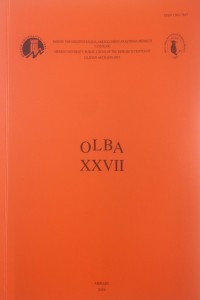THE AGE OF SPECIALIZATION. DIONYSUS AND THE PRODUCTION OF WINE IN LATE ANTIQUITY: A VIEW FROM SAGALASSOS (SW TURKEY)
Öz
Dionysus, the god of wine and fertility, was already a deity of importance in the Pisidian town of Sagalassos (SW Turkey) during the Roman Imperial period, one who left his mark on the local monumental landscape as well as on the accoutrements of daily life. Yet, in Late Antiquity Dionysiac imagery at Sagalassos, as in many other contemporary cities of the Greek speaking Eastern Empire, became the predominant iconographic subject in material culture while also remaining highly visible in the cityscape, reflecting a Hellenic cultural heritage that was no longer identified exclusively with paganism at the time. This paper questions how and why the images and vestiges of the cult of Dionysus remained omnipresent in this Pisidian city. Was this predominance of Dionysiac imagery on various elements of material culture the result of a form of henotheism - a stage of belief between polytheism and monotheism when a single deity achieves prominence but not exclusive worship - which established Dionysus as an opponent of Christ in an age of religious conflict? Or, conversely, had the god simply become an allegory of the vita felix or “the good life”, whose generic representations provided a suitable adornment for a drinking party? Or were there yet other factors at play? Insights into the contemporary economic landscape, which was characterized by a growing degree of specialization, may provide part of the answer. Especially an increasing investment in local viticulture and the production of wine, which sparked off new locally manufactured categories of material culture in the shape of amphorae and oinophoroi or wine flasks, appears to have been crucial. The success of this endeavour, mainly in intra-regional terms and occasionally beyond, may well have played an important role in the continued presence of Dionysus, as the symbol of this specialized branch of farming activities, on the public stage of the urban centre and its material culture for an extended period of time, until the ‘emancipation’ of Christianity finally did away with all residual pagan imagery
Anahtar Kelimeler
Kaynakça
- Ötüken 2003 Ötüken, S.Y., “Likya Bölgesi’ndeki Kazı ve Yüzey Araştırmaları Çerçevesinde Ortaçaǧ Seramikleri”, Adalya 6, 233-249. Özsait 1999 Özsait, M., “1997 Yılı Isparta ve Çevresi Yüzey Araştırmaları”, AST 16/2, 77-88. Pagenstecher 1913 Pagenstecher, R., Expedition Ernst von Sieglin, Ausgrabungen in Alexandria, II. Die griechisch-ägyptische Sammlung Ernst von Sieglin, 3. Die Gefässe in Stein und Ton; Knochenschnitzereien, Leipzig.
Öz
Kaynakça
- Ötüken 2003 Ötüken, S.Y., “Likya Bölgesi’ndeki Kazı ve Yüzey Araştırmaları Çerçevesinde Ortaçaǧ Seramikleri”, Adalya 6, 233-249. Özsait 1999 Özsait, M., “1997 Yılı Isparta ve Çevresi Yüzey Araştırmaları”, AST 16/2, 77-88. Pagenstecher 1913 Pagenstecher, R., Expedition Ernst von Sieglin, Ausgrabungen in Alexandria, II. Die griechisch-ägyptische Sammlung Ernst von Sieglin, 3. Die Gefässe in Stein und Ton; Knochenschnitzereien, Leipzig.
Ayrıntılar
| Birincil Dil | İngilizce |
|---|---|
| Bölüm | Araştırma Makalesi |
| Yazarlar | |
| Yayımlanma Tarihi | 25 Temmuz 2019 |
| Yayımlandığı Sayı | Yıl 2019 Sayı: 27 |


